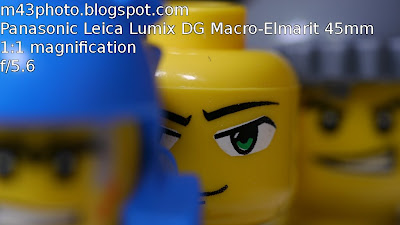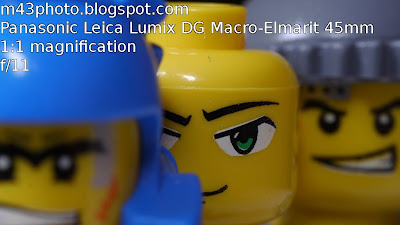The amount of diffraction depends on the pixel pitch, and the aperture opening. The sensor pitch depends on the sensor size and the number of pixels. The smaller the sensor, or the higher the number of megapixels, the more diffraction. Also, the smaller the aperture, the higher the diffraction.
For Micro Four Thirds cameras, it is generally said that one should be careful using apertures smaller than f/8. For example, f/11 or f/16 could potentially generate diffraction.
This can be a problem with macro photography, in which you will need to close down the aperture a lot to get sufficient depth of focus. How much can you close down the aperture before the diffraction becomes a problem?
In my reviews of the Olympus Zuiko Digital 50mm f/2 1:2 macro lens, and the Panasonic Lumix Leica 45mm f/2.8 1:1 macro lens, I have looked at the effect of stopping down the aperture on the depth of focus. In general, we see that with closeups, at least f/5.6 is needed to get a sensible depth of focus, unless the subject is pretty flat.
Here is a series of images taken as maximum magnification with the Panasonic Lumix Leica 45mm f/2.8 1:1 macro lens. Focus was set on the middle LEGO face eyes. The left face is 8mm to the front of the centre face, and the right face is 8mm to the rear. One LEGO unit is 8mm. Click on an image to view it larger.
f/2.8:

f/4:

f/5.6:

f/11:

f/22:

As you can see, the depth of focus increases as the aperture gets smaller. Looking at these scaled down images, it is hard to see much effect of diffraction, though.
To examine the effect of diffraction more closely, let's look at 100% views of the centre face mouth. Click on the image to view it larger.

What we see here, is that the image taken with f/22 shows some diffraction effect. It is less sharp than the other images.
Still, it is up to the user to decide what is more important: Depth of focus, or sharpness at pixel level. If it is important to have a large depth of field, I would say the image taken with f/22 is the best, despite some dullness at the 100% view. If used on the web, for example, this dullness would not matter at all, due to scaling the image down to fit a typical window. Looking at the series of images above, the latter one is the most sharp on overall, despite being less sharp when zooming in.
The conclusion here, I think, is that when using f/16 or smaller, there is some diffraction effect. However, you should not be afraid to use these apertures, if depth of focus is important. The photographer must decide what is most important.
You keep referring to "larger apertures", when you really mean larger aperture numbers. The apertures are actually smaller.
ReplyDeleteYou are right, thanks for the comment!
ReplyDeleteinteresting topic. Looking at the "sharpness charts" in lens reviews, the loss of sharpness beyond f8 seems dramatic. Here declining sharpness is visible, but not dramatic. One could compare the images with the widget in dpreview to see how the lines there compare with a real world test image.
ReplyDelete